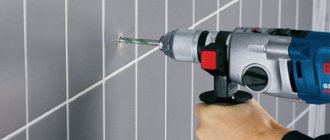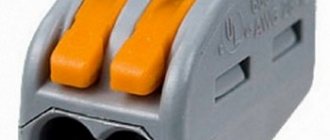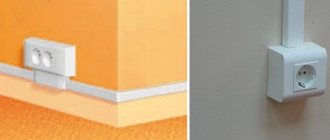How to make a hole in a tile for a socket: 6 ways
Ceramic tiles are a complex but attractive material for finishing. To make a hole in it for a socket and not spoil it, you need to have a lot of patience and experience. This article discusses several simple methods for high-quality processing of ceramic tiles. The described methods will help you make holes of any shape. But first, prepare the tool and familiarize yourself with the features of the work.
Required Tools
The holes can have different shapes. The simplest ones are square ones, and the more complex ones are round ones. Taking into account the planned shape, suitable tools are selected.
For square holes:
For round holes:
- diamond-coated crown;
- ballerina;
- drill;
- jigsaw
Which tool to use is up to everyone to decide for themselves. But whatever you choose, take into account the features of cutting holes in the tiles. This will make the job easier and help prevent damage to the material.
Features of cutting holes in tiles
- Ceramics have a smooth surface, so it is not always possible to keep the drill or bit from slipping. To solve this problem, make grooves using a punch and then drill along them. Masking tape or a special template will also help, which will prevent the nozzle from sliding.
- Place the tile in water for one hour. This will help prevent cracks from occurring in the future. Drill slowly at the lowest speed possible. Some craftsmen make holes directly in the water.
- Do not drill too close to the edge of the tile; the edge may break off. The minimum distance to the edge of the ceramic is 15 mm.
- Drill the tiles that are already fixed to the wall with a hand drill.
Methods for cutting a hole for a socket
If the work is carried out by professional craftsmen, they will have a whole arsenal of tools. And for those who are faced with the need to cut out space for an outlet for the first time, you can use the following methods:
- A hammer drill with a crown for socket boxes;
- Drill bit and glass;
- Ballerina;
- Hacksaw and diamond wire;
- Bulgarian;
- Hand jigsaw.
Before starting work, the tiles need to be soaked in water for 1-2 hours. You need to drill holes at low speeds. If the tiles are already on the wall, it is better to work with them using a hand drill. You should not make a hole that is too close to the edges of the material - it is better to maintain a distance of 1.5 cm from the edge.
Methods for cutting holes in tiles
The difficulty of installing a socket in tiles is that it becomes necessary to cut holes. There are several useful tools that can help you do this difficult job.
Hand jigsaw
This is one of the simplest tools that can be successfully used. To use it to cut ceramics, you need to buy a tungsten filament. The string is sold at any building materials store. Using a jigsaw, it is convenient to make a round and square hole for a socket, while minimizing the risk of splitting the tile. The disadvantage of the tool is the use of physical force. If you need to make a lot of holes, you can easily get tired.
- Make an outline of the future hole on the glossy side using a marker.
- Drill a starting hole in the center of the outline with a drill. Thread the tungsten thread, securing it to the jigsaw.
- Saw smoothly, from the inside, next to the contour. Try not to go into the markings so as not to cut too much.
- After making the hole, sharpen the edges with sandpaper.
- Place masking tape on the tile.
- Draw a circle of the desired diameter using a marker.
- Place a board under the tile.
- Insert the bit into the drill and start drilling at low speed, slowly going deeper.
- The nozzle will become very hot. To cool, periodically dip it in water.
- After making the hole, smooth the edges with sandpaper.
Diamond coated crown
To quickly cut ceramics, use a special round nozzle. It has a cutter reinforced with diamond chips that effectively grinds hard ceramics. The result is a perfectly round and smooth hole. The crown has different diameters, which are selected depending on the size of the rosette. If the cutter wears out, you can buy another one and solder it in place of the old one. This allows you to significantly save on the purchase of a new nozzle.
Ballerina
This is a drill attachment that works on the principle of a compass. It consists of a centerpiece in the form of a drill and one or two cutters located in parallel. Ballerina is used to create round holes in ceramics and glass. The cutters are adjustable horizontally - you can adjust the required diameter.
- Make a central recess in the tile using a regular drill bit.
- Place the ballerina on the drill and adjust the diameter.
- Insert the center pin into the hole you have made and start drilling at low speeds. The lateral incisors will scratch the ceramic, gradually going deeper.
- Once you've reached the halfway point of the tile's thickness, flip it over and start cutting a hole from the back until a circle appears.
Methods for cutting a hole in a tile for a socket
The choice of method for carrying out this procedure depends not only on the availability of a specific tool. There are a couple more nuances to consider. If the tiles have already been laid, the options with a hacksaw and a jigsaw are not suitable. Getting a square-shaped hole is not difficult with the help of an ordinary grinder and an inexpensive cutting wheel.
What exactly to use in practice in order to drill a tile for a socket , everyone decides independently, but it is necessary to take into account:
- If the edge of the hole being made is less than 15 millimeters from the edge of the tile, there is a high probability of cracking of the tile;
- If you are processing tiles that are not fixed to the wall, they must be placed in water for some time;
- Tile is a material on which a crown, “ballerina” or drill can slide, which implies the use of a core, masking tape or a template.
We use a drill and a crown
A hammer drill can also be used as a tool, but you should make a hole in the tile for the socket in drill mode. Otherwise, damage to the material is inevitable.
Regardless of what kind of crown is used (carbide or pobedite brazing, diamond coating), the drilling process is as follows:
- Insert the bit into the hammer drill or drill and press firmly;
- Draw a circle of the required diameter on the front side of the tile;
- Without pressing too hard, cut out a hole.
If the tiles are not laid on the wall, they must be placed on a flat wooden surface.
Fewer chips are usually obtained when using a diamond-coated crown. But in any situation, uneven edges can be “cultivated” using sandpaper or a file.
Making a hole in the tile for the socket using nibblers
Another name for a device in the form of nibblers that allows you to drill a tile for a socket is “ballerina”. This tool is a bar with a drill and adjustable cutters. Having established the required distance between the cutting elements, we place the device in the chuck of a power tool (drill, mixer, hammer drill), and drill a hole.
Using a grinder
This option cannot be called completely simple. What matters here is the shape of the desired hole. If it is a square, the process will be easier, if it is a circle, it will be more difficult. But often during repairs this method is preferred. The reason is simple: every owner tries to purchase a power tool in the form of an angle grinder, even if he is not a builder and does not renovate premises. All that remains to be done is to buy a diamond-coated cutting wheel, after which cutting out the tiles for the socket will not be difficult.
This is done like this:
- The surface is marked;
- The tiles are carefully cut along the edges;
- Through cuts are made in the center of the future hole;
- Using pliers, the pieces of tile remaining at the edges are broken out, which are subsequently processed with a file, sandpaper or other abrasive material.
How to make a hole using a drill and a pobedit bit
This option is the most labor-intensive and requires precision and patience. This method is recommended if the tiles are already laid on the surface. Otherwise, the tile will most likely crack, especially if you don’t have much experience in this matter. But there is also an advantage here. The option, like using a grinder, is inexpensive and does not require the purchase of expensive crowns.
The hole for installing the socket under the tile using this method is made as follows:
- Masking tape is pasted in the right place, which must prevent the pobedit or diamond drill with a diameter of 4-6 millimeters from “fidgeting” in the glaze;
- Draw a circle or square with a marker;
- On the inside of the circular mark, so that the edge of the hole being drilled extends 2-3 millimeters beyond the line, points are marked in a circle;
- Drilling is carried out at existing points;
- Using nippers, remove pieces of tile remaining between the holes;
- The middle is removed in any convenient way (it is advisable to use a grinder).
Watch a video tutorial on how to make a hole for a switch in a tile before you start working.
A great option is to use a jigsaw
You can also cut tiles for a socket In this case, you will need a drill with the same diamond coating. The method is quite simple, but it is only suitable if the tiles are not laid on the wall. The steps are as follows:
- Drill a hole of small diameter;
- We make markings;
- We insert the canvas and cut it out.
Similarly, you can use a hand tool in the form of a hacksaw for metal with a blade that cuts tiles. In this case, the direction of movement of the canvas should be from the front side of the tile. This will avoid chipping. In this article we tried to explain in more detail and clearly how to make a hole in a tile for an outlet and other items.
And for a complete analysis of the lesson on how to make a hole in a tile for a socket, you are presented with a video (part 1):
Methods and tools for cutting a hole in a tile for a socket or pipe
In the process of renovating a house or apartment, it is often necessary to carry out operations that require a special approach to them. For example, a hole in a ceramic tile. This situation occurs quite often, because in kitchens, bathrooms, showers and other rooms where ceramic cladding is used, sockets, pipework, ventilation vents, chimneys, and so on are installed. and for them in the finishing you will have to make holes of different shapes and sizes. Therefore, it is worth considering all the ways to carry out this process. For example, how to make a hole in a tile for an outlet.
Using an angle grinder
The question of how to make a large hole in a tile arises in cases where it is necessary to install pipes or other plumbing communications in a bathroom or toilet, and also, if necessary, install an electrical outlet in these rooms. If the tiles are not yet fixed to the wall, then you can make a hole in this product for a pipe or socket using a regular grinder.
Start cutting a round hole with a grinder by stepping back slightly inward from the intended circle
Using a grinder, a shaped or round hole in a ceramic tile is made in the following sequence:
- The contours of the future hole must first be marked, for which you will need a marker.
- The angle grinder should be equipped with a diamond blade designed for dry cutting.
- You need to start cutting from a convenient edge of the tile, moving the tool away from you.
- When cutting a hole in a tile for a socket or pipe, you can stop at any time and start processing from a more convenient side, but then there is a chance that the cut lines being formed will not converge.
It should be kept in mind that you should only use a grinder to create a shaped or round hole in ceramic tiles from the front part of the product. At the same time, it is necessary to control that the cut is smooth, neat and without chips. When performing this procedure, strict safety precautions must be followed to minimize the risk of injury.
Hole cutting methods
Before proceeding with the analysis, you need to familiarize yourself with some rules and warnings.
- Making a hole in a rectangular tile is easier than making a hole in a round one.
- Ceramic tiles have a glossy surface of increased smoothness. The cutting tool may slide on it, which will lead to its inaccurate installation. In any case, this will not be so easy to do. Therefore, it is recommended to make notches on the surface of the tile, for example, with a core. This can be a point or linear notch.
- If you place the tiles in water for one hour before drilling, you can avoid the appearance of cracks when cutting.
How else to drill a hole in tiles
Home craftsmen often have a question about how to make a hole in a tile that is already fixed on the wall. In such cases, a hole in the tile can be created using a cone or twist drill.
Processing using a conventional drill takes place in several stages.
- Paper tape or adhesive tape is glued to the place where drilling is to be done, which will prevent the drill from slipping off the smooth surface of the tile and protect it from scratches and other mechanical damage.
- The center of the future hole is marked using a regular marker.
- After this, they begin to make a hole in the tile at low speeds of the drill.
- To prevent the drill from overheating, it must be moistened with water from time to time. After the tool goes deep into the material being processed, you can cool the tile itself.
If you need to make a hole of a large diameter in the tile, you can carry out this process in stages - using tools of various sizes. You can also get a large-diameter hole in a tile using another method, which involves making a large number of small-diameter holes along its contour. Then the inside of the hole is simply knocked out along its contour, and the edges are sanded.
Crowns and ballerinas
There are special tools that can be used to easily make a smooth hole in a tile for an outlet or pipe. The easiest way is to use a crown of the appropriate diameter. It is put on the drill, installed exactly at the location of the drilling process and turned on. In just a few seconds, a diamond cutting tool makes an even hole of the required diameter in the tile.
In order not to displace the tool relative to the center of the hole, it is necessary to choose it with a centering element. This is a cone sticking out in the middle, which will need to be installed exactly in the center of the future hole. You can use special templates made of metal or plastic for drilling. They are installed on the tile plane in the required place, and a hole is drilled through it with a crown. The template prevents the tool from moving to the side. In this case, one template can have several holes with different diameters.
By the way, crowns can be different in terms of cutting edge. This can be a regular edge coated with diamond or tungsten. Crowns can be equipped with teeth of different configurations, made of pobedite or carbide tipped.
Attention! The vibration of the drill causes the tile to break. Therefore, a wooden substrate must be placed under it. You only need to drill at low speeds; one hole usually takes 1-2 minutes.
As for the ballerina, this is an ordinary drill with two cutters installed on both sides. All three cutting tools are located on one holder. There is also a ruler on it, which can be used to set the distance from the drill to the cutters, which determine the radius of the future hole on the tile. It is important to correctly position the drill in the center of the circle being cut. The cutting tool is installed in a standard drill chuck.
It should be noted that these two cutters (crown and baller) are the best way to cut a hole in the tile. Its edges will be smooth, clean, without burrs or chips. If the process is carried out correctly, cracks will never appear, because the cutting edges themselves are either diamond coating, tungsten, or hardened steel. That is, materials that can withstand heavy loads and cut almost any hard material.
Tungsten string
There is a cutting tool that is made entirely of tungsten (the name makes this clear). It is very similar to a blade from a hacksaw for metal, and is made in its likeness with the same type of fastening. When used, such a string is installed on a hacksaw. How to use it to make a hole in a tile for a pipe or socket.
- First, you need to apply a circle to the tile itself, which will determine the location and size of the future hole.
- Then, anywhere in the circle, preferably near the edge, make a small diameter hole using a drill and drill bit.
- A string is inserted into it, which is then attached to a hacksaw.
- Now you can cut a hole in the tile exactly according to the markings. If the hole from the drill bit was not made at the very edge, then you need to saw through to the border, and only then strictly move along the drawn circle.
Glass cutter
Some craftsmen claim that using an ordinary glass cutter and wire cutters you can drill a hole in ceramic tiles. But with one caveat, if this hole must be drilled near the edge of the tiled element.
As usual, before cutting out a piece of ceramic, you need to mark the shape and dimensions of a circle on the surface of the tile. After that, an incision is made exactly along the line with a glass cutter. It is very important to make the cut deep, but at the same time create as little pressure as possible on the tile. You overdid it and got a crack or break in the material.
Next, you need to tap the material on the back side of the tile. Thereby increasing the depth of the cut. That is, everything is done exactly the same as with cutting glass. Then you take wire cutters or pliers in your hands and use them to bite off pieces of ceramic material according to precisely applied markings. After which the edges are processed to maximum evenness.
Bulgarian
Unfortunately, it is almost impossible to cut round holes in ceramic tiles with a grinder. Especially if they are small in diameter. The diamond cutting blade is too large for such operations. But you can cut a rectangular section without any problems. It's done like this.
- If possible, the cuts are made through along the applied contour. If this is not possible (the rectangle is small), simply make notches with a disk along the entire perimeter of the figure.
- Through cuts are made in the middle of the rectangle (along or across, preferably diagonally).
- Next, the cut piece is broken in any way, you can even hit it with a hammer. The main thing is not to break the outer edges.
- Now use wire cutters or pliers to straighten the edges.
- After which you can use a file to remove sharp pieces protruding beyond the contour.
Socket sizes
The diameter of this element is usually no more than 70 mm. This size is the most common, so finding a socket box with this parameter in stores will not be difficult. In addition, the dimensions of the sockets themselves correspond to the specified parameter.
The depth of the installation box is one of the key values that you should pay utmost attention to.
The depth must be selected in such a way that after installation, the socket box does not protrude beyond the limits of a particular covering.
Typically, containers for placing sockets have different widths. It depends on how many wires will be inside.











